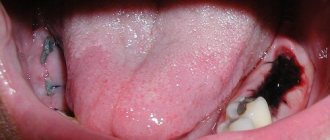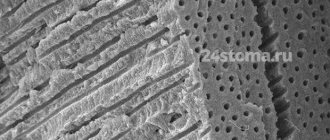If you have a toothache under a crown, do not panic - unpleasant sensations can occur immediately after a visit to the doctor and the installation of the structure itself.
Most likely, the pain will subside within 2-3 days. However, if a tooth begins to ache under a crown that was installed quite a long time ago, this is a reason to visit the doctor again. The possibilities of modern dentistry make it possible in most cases to save the tooth and the crown installed on it - the prognosis mainly depends on whether the “living” tooth hurts or whether it has already been depulped previously. There are several common reasons why a tooth hurts under a crown.
Causes of pain
As a rule, before installing a crown, the tooth is depulped - that is, the neurovascular bundle in the root and coronal part is removed, after which the canals are filled. Pain may be caused by some features of these manipulations:
- incomplete filling of the canals - as a result of the formation of voids in the root canals, an infectious process may begin to develop; Pus accumulates at the root tip, which causes pain. This is a common complication of endodontic treatment, especially in cases where the canals are too narrow or curved;
- subsidence of filling materials over time - even if the root canals are completely filled, changes in the physical properties of the materials can also lead to the appearance of voids - infection develops in them, inflammation spreads to the tissues near the apex of the tooth root;
- removal of the filling material beyond the root apex - “excess” material in the periodontal tissues can provoke irritation and inflammation.
Pulpitis. Inflammation of the pulp can occur in cases where a decision was made to preserve it - tooth processing can lead to a burn, the infectious process may already begin in the pulp and be asymptomatic, which becomes the cause of inflammation. Preserving living pulp before installing a crown on a tooth is a rare occurrence; as a rule, the “nerve” must be removed.
Perforation of the walls of the root canal. Perforation is the creation of a hole in the root canal, a phenomenon that occurs for several reasons:
- perforation may be a consequence of mechanical processing of the canal with a thin instrument - it must enter the canal along its entire length. If the canal is curved, then even a slight pressure can cause the instrument to pass through the tooth tissue;
- installation of a pin can lead to perforation - it is installed in the root canal, which, given the appropriate anatomical features of the structure of the root system, can also lead to the formation of a hole.
The hole is a “gateway” for infection—the tissue becomes inflamed some time after the pin is installed or endodontic treatment is performed, which causes pain.
Why does the tooth under the crown hurt?
The reason for this may be the presence of a foreign body in the canal. During endodontic treatment, the tip of the instrument may break off; subsequent filling of the canal with a foreign body leads to pain. There can be several reasons for breakage - the most common of them is the curvature of the canals. If they are difficult to pass, the tool may break due to the high load.
As a rule, in this case, the patient feels pain when exposed to temperatures, and the tooth under the crown also hurts when pressed. Pulsation may appear during exertion or chewing on the side with the crown installed. Tapping on a tooth also causes discomfort.
In order to avoid such a complication, the dentist must perform an x-ray diagnosis before installing a crown or any other dental prosthesis.
If the technology for processing and preparing the tooth for prosthetics is followed, installing a crown can also cause pain - if the design is too high for the bite, the patient feels discomfort when closing the jaws. This is why the stage of “trying on” the crown before its final installation is important - a good orthopedic dentist will first assess the degree of comfort for the patient.
Types of tooth displacement
While everything is quite clear about why teeth shift, many people are confused about the types of this problem. All bite defects are divided into 3 large groups.
- Violation of the position of the teeth: normally there are very narrow spaces between the teeth, and each tooth, except the last in the row, has 2 contact points with its neighbors. If there are enlarged spaces (tremas, diastemas) or teeth are crowded, then this is a defect that needs to be corrected - otherwise it will lead to problems with the gums and increased tooth wear,
- Violation of the development of dentition - they can be either narrowed or expanded.
- Abnormalities affecting the size or position of the jaws. These include:
a) cross bite - the jaws close in a cross direction horizontally, i.e. the teeth overlap;
b) mesial bite - the lower jaw protrudes forward;
c) distal bite - the upper jaw protrudes forward.
If any tooth has changed position as a result of injury or removal of an adjacent tooth, this is also a malocclusion that can be corrected by orthodontists.
A pulpless tooth hurts
If the pulp has been removed, the pain is most often aching. It can radiate to the temple or ear. The main reason for this phenomenon is the exacerbation of chronic periodontitis. The choice of therapy method is determined by the presence or absence of a pin in the tooth root canal:
- there is no pin: the doctor opens the crown, unseals the root canals and treats them properly, after which he places materials impregnated with antibacterial agents into the tooth. Several changes to the medication may be required until complete relief is obtained and the inflammatory process is eliminated. After the symptoms have completely subsided, the canals are filled again and a new crown is installed;
- there is a pin: the doctor can cure periodontitis through surgery - resection of the apex of the tooth root. It is performed through a small incision in the gum, through which the source of infection is removed, and if necessary, the resulting void is filled with osteoplastic material. Typically, the intervention lasts from 30 to 60 minutes and is well tolerated by patients.
Duration of figure eight eruption
The process is long and painful. Since they erupt in adulthood, the bone tissue is formed, it is harder for the tooth to pass through the bone. If there is a place on the jaw, it appears painlessly. If it is not enough, the person faces difficulties. Let's look at the signs that indicate problems with wisdom teeth. When a wisdom tooth breaks through the bone, the symptoms are as follows:
- Painful sensations and swelling. During chewing, unpleasant sensations arise.
- When the tooth does not cut through the gum, it lifts it and forms a hood. When food and bacteria enter, inflammation develops.
- Sore throat often occurs as a result of inflammation spreading to nearby tissues.
- Unpleasant sensations in the ear, including otitis media or otalgia.
- Along with eruption, the lymph nodes become inflamed and lymphadenitis occurs.
- It happens that the figure eight, the eruption of which is just beginning on the gum, is partially located in the mandibular canal.
- There is a feeling of stiffness that extends over half of the head.
- If the dentition becomes crooked, there is no room left for the eighth molar. It will not fall out, but will move the formed row and make room for itself.
Gum pain
If the gums hurt, and not the tooth itself with a crown installed, there may be a deformation of the crown or a discrepancy in its size - the gums are mechanically damaged, which leads to inflammation and pain. For example, the edge of the crown extends under the gum or, on the contrary, does not reach its edge significantly - in the first case, a sharp edge can lead to soft tissue injury and inflammation. Moreover, it is worth noting that the pain can radiate into the tooth itself, which makes self-diagnosis difficult - the patient simply does not understand that it is the gums that hurt, and not the tooth under the crown.
If the crown does not reach the edge of the gum, the tooth under the crown hurts greatly - but not immediately after installation, but after quite a long time. The retention of food debris between the edge of the structure and the gum leads to the proliferation of pathogenic bacteria, the development of caries, and the destruction of tooth tissue under the crown. This leads to severe pain, tooth reactions to temperature, stress, etc.
The doctor’s tactics in this case is to remove the unsuitable crown; this is the only measure that a specialist can take to eliminate the problem.
If the gums are swollen, and even more so in cases where there is swelling of the cheek, there is most likely inflammation in the area of the apex of the tooth root. As a rule, swelling forms in the projection of the apex of the root of the causative tooth. You cannot do without a visit to a dentist - he will decide on the choice of treatment method taking into account the condition, structural features of the dental system, and the severity of the disease.
A fistula on the gum often forms a certain time after the appearance of swelling. This happens because the pus accumulated at the apex of the root requires release - after its outflow is established, the symptoms may subside, but this does not mean that the disease has passed. In this case, a visit to the doctor is mandatory - it is important to treat the disease and prevent possible complications.
Indications for removal
Retention can manifest itself as a stage of eruption. Over time, the crown completely appears above the gum and the tooth can function normally. Therefore, the decision on the need for removal should be made by a doctor only after examining and diagnosing the condition of the dental system. Indications for surgery are the following clinical cases:
- Constant pain;
- Complications of eruption;
- Trauma to an adjacent molar;
- Pressure on the dentition and its deformation;
- Horizontal or angular position of the third molar in the jaw;
- Dental crowding, which can be aggravated by wisdom teeth;
- Orthodontic and orthopedic indications, that is, the need for extraction to correct the bite or prosthetics.
When is pain normal?
Even a perfectly installed crown can provoke painful sensations immediately after prosthetics - as the local anesthesia wears off. The pain may be constant or occur with pressure. How to distinguish these sensations from those caused by pathology?
Firstly, pain normally lasts no more than 1-3 days - this is due to the adaptation of tissues to the new structure in the oral cavity.
Secondly, the pain tends to subside. Increasing sensations indicate a pathological process.
Correction of misaligned teeth
What to do if you see, for example, how the teeth on the lower jaw have shifted?
It seems to many that it is no longer possible to correct the situation in adulthood - the teeth will still return to the wrong position, and besides, correcting the bite is long, difficult and unaesthetic. Fortunately, orthodontists today are successfully correcting misalignments in adult patients. To do this, they use 2 orthodontic systems, which, using the pressure of a calculated force, carefully move the teeth to the correct position.
- Braces
A classic non-removable system that consists of a metal arch, braces - elements that are fixed to each tooth, and locks or ligatures that secure the arch in the braces. Today, these systems have become much more compact and comfortable, and we are no longer talking about long years of correction, since the average treatment period is only 1.5–2 years. Doctors have metal, ceramic, sapphire and combined systems at their disposal. There are also lingual braces - they are fixed on the lingual side of the teeth and are not visible when you smile. - Aligners
A removable system of aligners developed about 3 years ago that are worn on the teeth. For each patient, based on photographs and impressions of the jaws, an individual set of aligners is created, which the patient himself changes according to a schedule drawn up by the orthodontist. Unlike braces, aligners can be removed for 2 hours a day to eat and brush your teeth.
However, in any case, after removing the orthodontic system and completing the bite correction, a period of retention follows - when the patient wears retainers that prevent the teeth from returning to their previous position.
How to help yourself if the tooth under the crown hurts?
A tooth hurts under a crown - how to relieve the discomfort? It is important to make an appointment with a doctor first. Painkillers can be used as temporary measures, but you should consult with your doctor about the advisability of their use. It will not be possible to eliminate the cause of the pain at home - you can only alleviate the symptom a little.
You can resort to rinsing the mouth with warm water, in which 1 tsp was previously diluted. salt. A weak decoction of chamomile can also be used after first checking the temperature of the product - it should be room temperature.
Avoid heating the diseased tooth - hot compresses can lead to complications. Also, you should not apply “burning” products like garlic to the gums - you can get a burn to the mucous membrane.
Function of the eighth molars
Dentists call them spares. Where does the wisdom tooth grow? It stands on par with the others, is classified as molars, but is practically not used for chewing food. The main purpose is to hold teeth so that they do not become loose and move apart. If a nearby molar is lost, it will take its place and perform the necessary functions. During dental prosthetics, the figure eight can become a support. During development, the human skull has changed, the jaw has become smaller and there is no room for a molar. Young people do not have such a tooth even in its rudiments.
How to prevent pain?
Prevention of toothache under a crown includes following your doctor’s recommendations: crowns should be brushed just like your own teeth - at least 2 times a day. It is worth paying special attention to cleaning the spaces between the teeth and around the gums - this is where the largest amount of food debris and plaque accumulates. It is recommended to use not only a toothbrush and toothpaste, but also dental floss and, if possible, an irrigator.
You will have to refrain from eating solid foods - seeds, nuts, in order to avoid damage to the crown.
Visit your dentist at least once a year to monitor the quality of your dentures.
Example 3. Chronic periodontitis, significant root exposure, tooth mobility
If chronic periodontitis (periodontal disease) is accompanied by significant loss of bone tissue (more than ½ of the root length), tooth mobility, and exposure of root bifurcations, tooth extraction is the only possible solution to the problem.
In the case of periodontal disease, the main problem is the presence of periodontal pockets and loss (atrophy) of the bone tissue around the teeth. The roots are gradually exposed, and tooth mobility appears. If the periodontal pockets are so deep that even periodontal surgery cannot solve the situation, it is necessary to remove such teeth, because Millions of microbes accumulate in the pockets, which further “corrode” the bone. It is better not to wait until the teeth fall out on their own, but to remove the source of infection, thereby preventing further loss of bone tissue and leaving the possibility of implantation.
Symptoms of dystopia of the 3rd molar
It is impossible to visually or tactilely determine the position of the growing figure eight. Among the symptoms indicating abnormal growth of this dental unit are:
- inflammation of gum tissue;
- the appearance of a “hood” of soft tissues;
- dull pain in the jaw;
- painful pressure on the root of an adjacent tooth;
- acute pain in the area of the second molar;
- enlargement of the submandibular lymph nodes;
- inflammation of the trigeminal nerve (pain in the jaw, back of the head, ear).
It is important not to try to diagnose yourself, but to go straight to the doctor. Among the methods for diagnosing this anomaly, the most effective are:
- radiography - an x-ray of the affected area;
- orthopantomogram - panoramic x-ray of the jaw;
- cone beam tomogram - used in severe cases.
Diagnostics using special medical equipment allows you to most accurately determine the position of the dental unit, the condition of the roots and bone tissue. Based on the diagnostic results obtained, the dentist makes a decision on methods of treatment or extraction of the problem tooth.
What to do: treat a wisdom tooth or remove it?
Many people are often interested in the question: is it better to use the services of a dentist at the stage of intramaxillary development and remove a rudimentary tooth so that it does not create problems later?
However, most experts agree that preventive removal of eights is unacceptable. When the tooth has erupted correctly and does not cause any discomfort, it can be preserved. The main thing is to carefully observe the rules of hygiene and visit the dentist on a regular basis to monitor and perform hygiene procedures.
Removal is resorted to in cases where conservative treatment methods cannot achieve the desired result.
Treatment methods
If a tooth without a nerve hurts under the crown, the specialist will determine the cause of the pain and apply the most appropriate treatment method. Most often, the artificial crown is removed, as it will interfere with the treatment. But sometimes specialists carry out therapy without removing the structure. A small hole is made on the chewing surface of the tooth and crown through which treatment procedures are carried out. Depending on the clinical situation and the cause of tooth pain under the crown, treatment tactics may be as follows:
- Removing the crown and making a new one. The doctor eliminates the inflammatory process, treats and re-seals the canals.
- Crown removal, treatment and re-fixation. If possible, after treatment, the doctor can install the same crown on the tooth. But this method is rarely used, since more often the structure is deformed during removal.
- Treatment through a crown. Treatment of lateral teeth in some cases can be carried out through the structure, provided there is good access.
- Removing the crown and performing tooth-preserving surgery. To preserve the tooth as a functional unit, operations are used that involve removing the source of inflammation with part of the tooth: hemisection (removal of one root), coronary-radicular separation (removal of half the tooth), resection of the apex (removal of the upper part of the root from the sites of inflammation, cyst) .
- Tooth extraction is a last resort measure of treatment, which is used when it is impossible to save the tooth with therapeutic methods.
Recovery period. Recommendations and contraindications
Any invasive surgery leads to a long recovery period. After removal of a wisdom tooth, the patient may feel:
- general weakness and drowsiness;
- swelling of the soft tissues of the gums;
- dull aching pain in the area of the operation;
- increase in body temperature.
With high blood pressure, as well as during the menstrual cycle in women, repeated bleeding from the wound may occur.
The following recommendations will help speed up the healing process and restoration of damaged gum areas:
- You should not eat or drink for several hours after surgery;
- during rehabilitation it is necessary to limit yourself in smoking;
- You can’t take a hot bath for a couple of days (wash only in the shower);
- Do not sunbathe or overheat for 2 weeks;
- you need to take a course of prescribed antibiotics;
- You should carefully rinse your mouth with antiseptic solutions.
Of course, your doctor will give more complete and, most importantly, personalized instructions, following which you will speed up the recovery process. It is only important not to neglect professional advice, and then within a few days you will feel like a completely healthy person.
What to do at home?
If a tooth with a crown hurts, then you need to quickly visit a specialist - a dentist. Before visiting a doctor, you can take the following measures:
- Take a pain reliever. It is better to use medications from the group of non-steroidal anti-inflammatory drugs - Paracetamol, Nimesil, Ibuprofen, Tempalgin, Ketanov;
- Carefully carry out hygienic cleaning of teeth and interdental spaces;
- Rinse the mouth with decoctions of medicinal herbs;
- Rinse with a salt-soda solution every 1-2 hours. To prepare the solution, you need to dissolve 1 teaspoon of salt and soda in 200 ml of boiled, slightly cooled water.











